Charles E W Bean, Diaries, AWM38 3DRL 606/243B/1 - 1916 - 1926 - Part 12
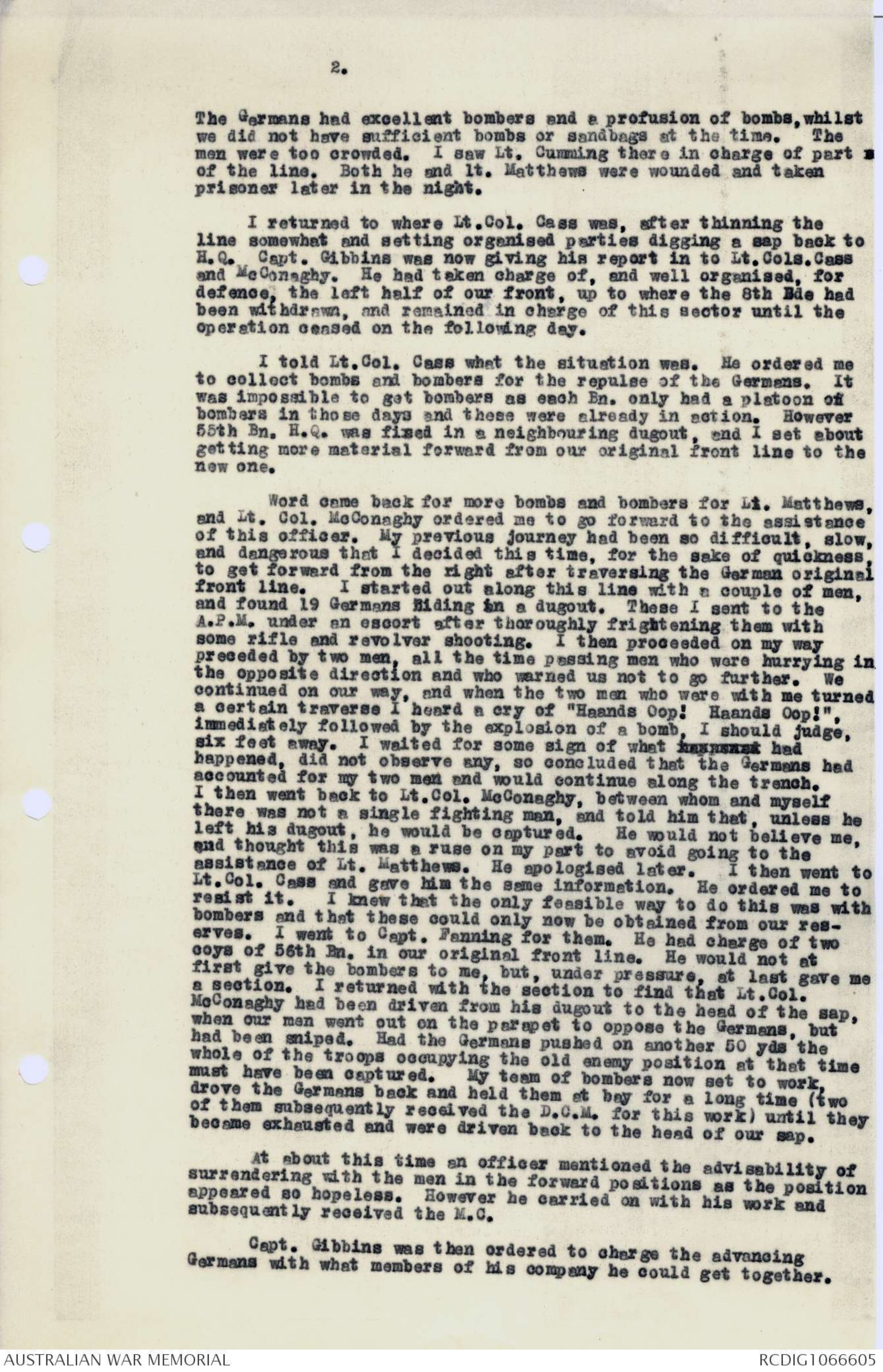
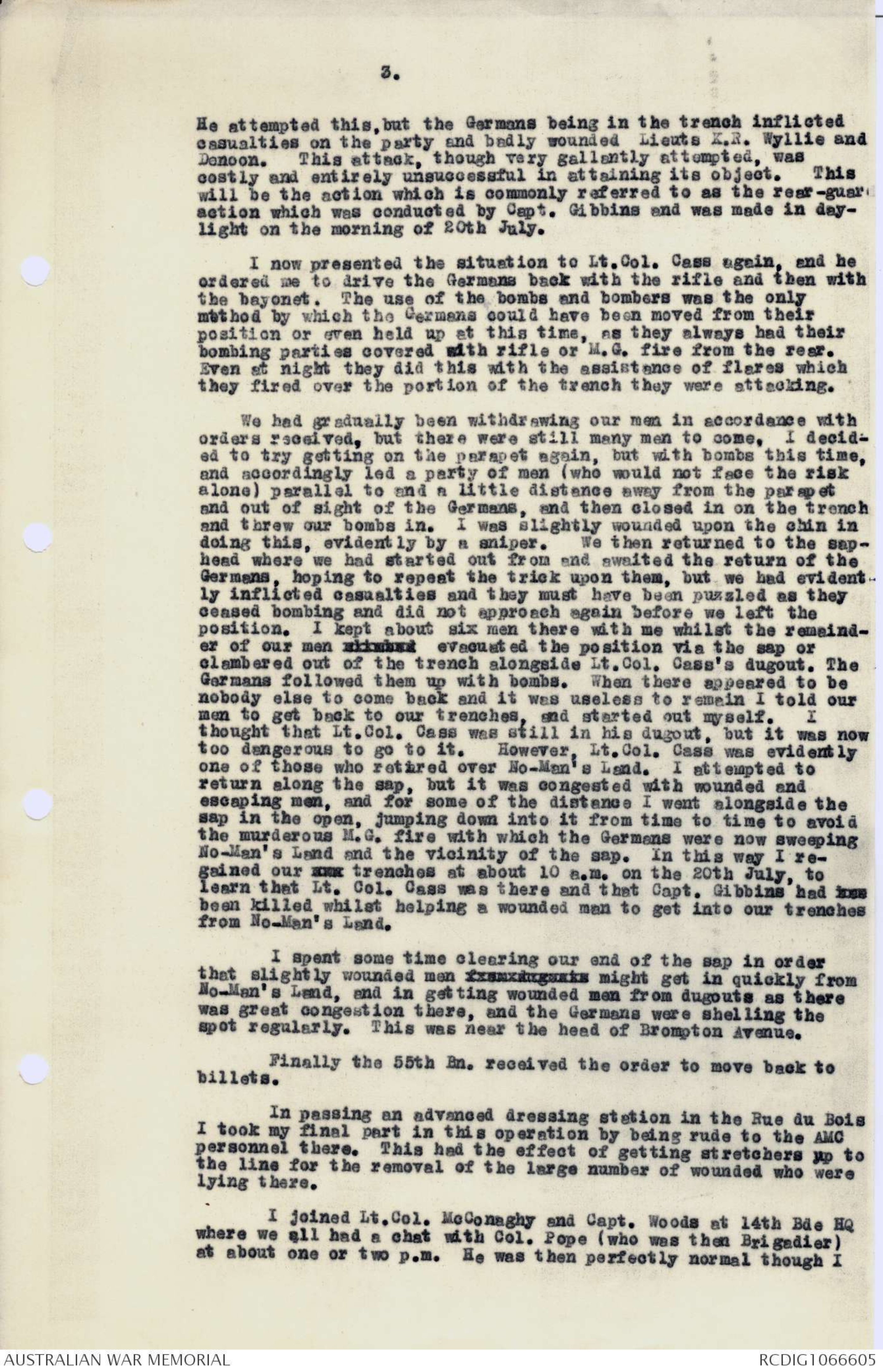

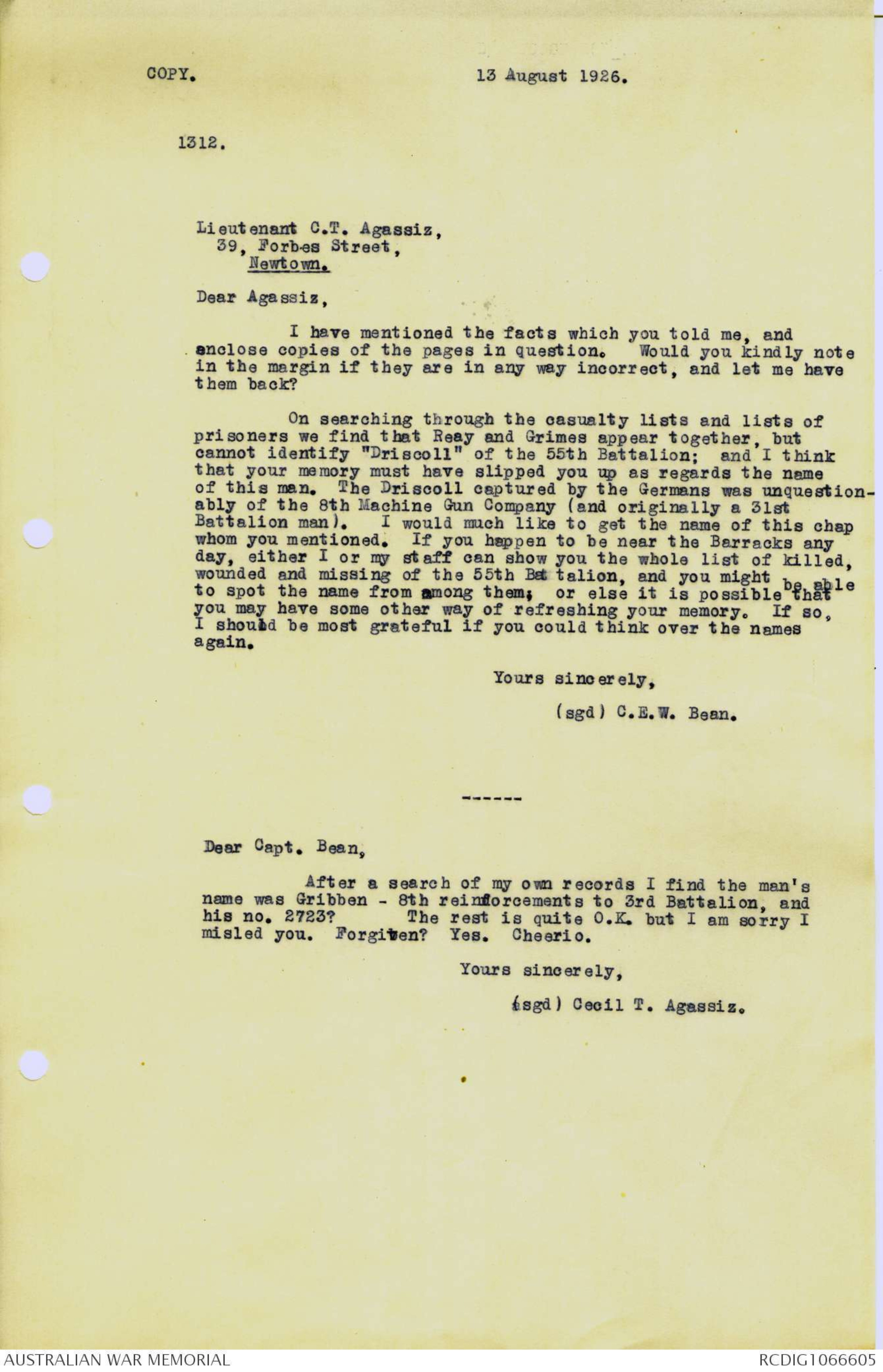


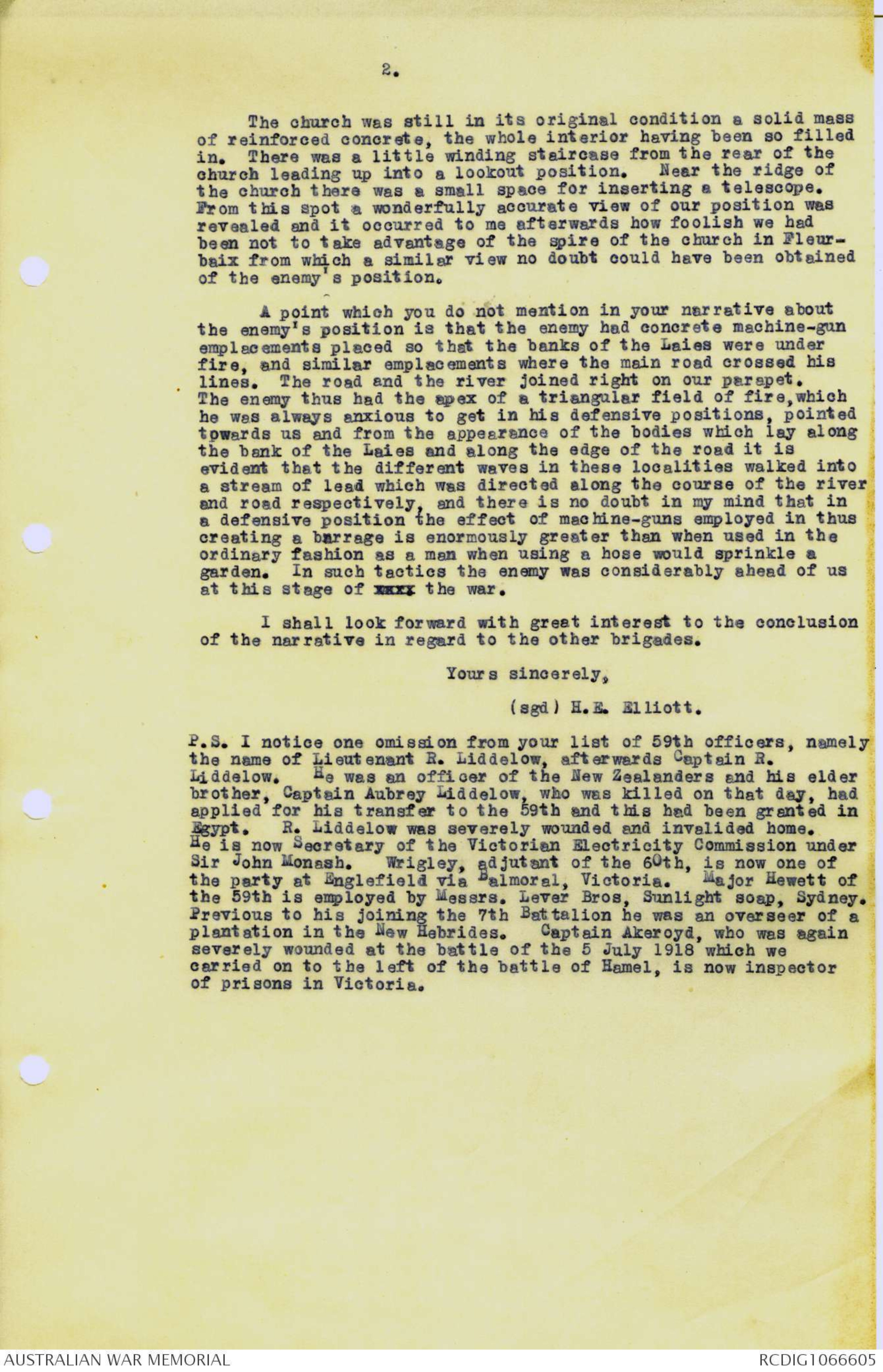
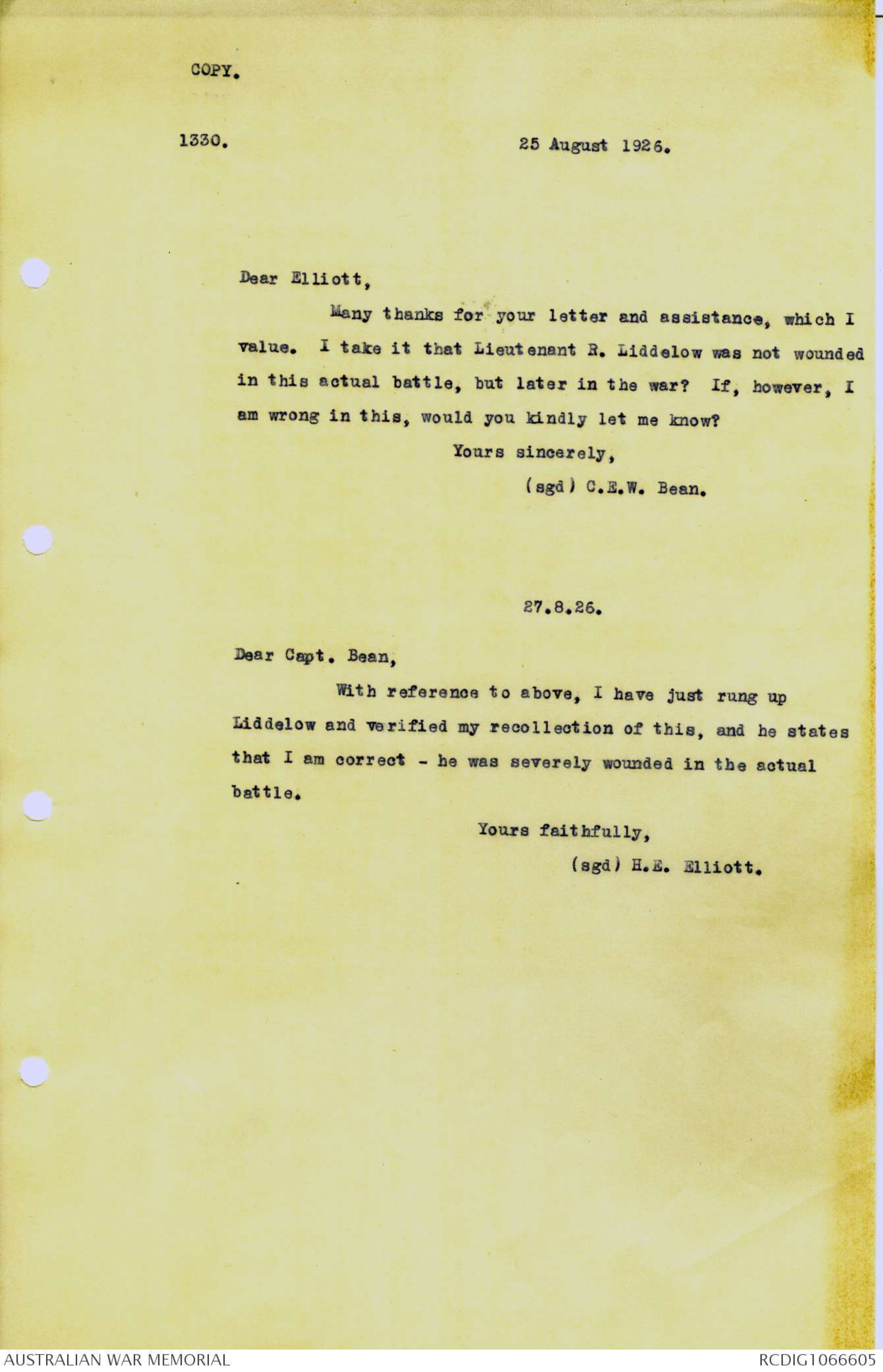
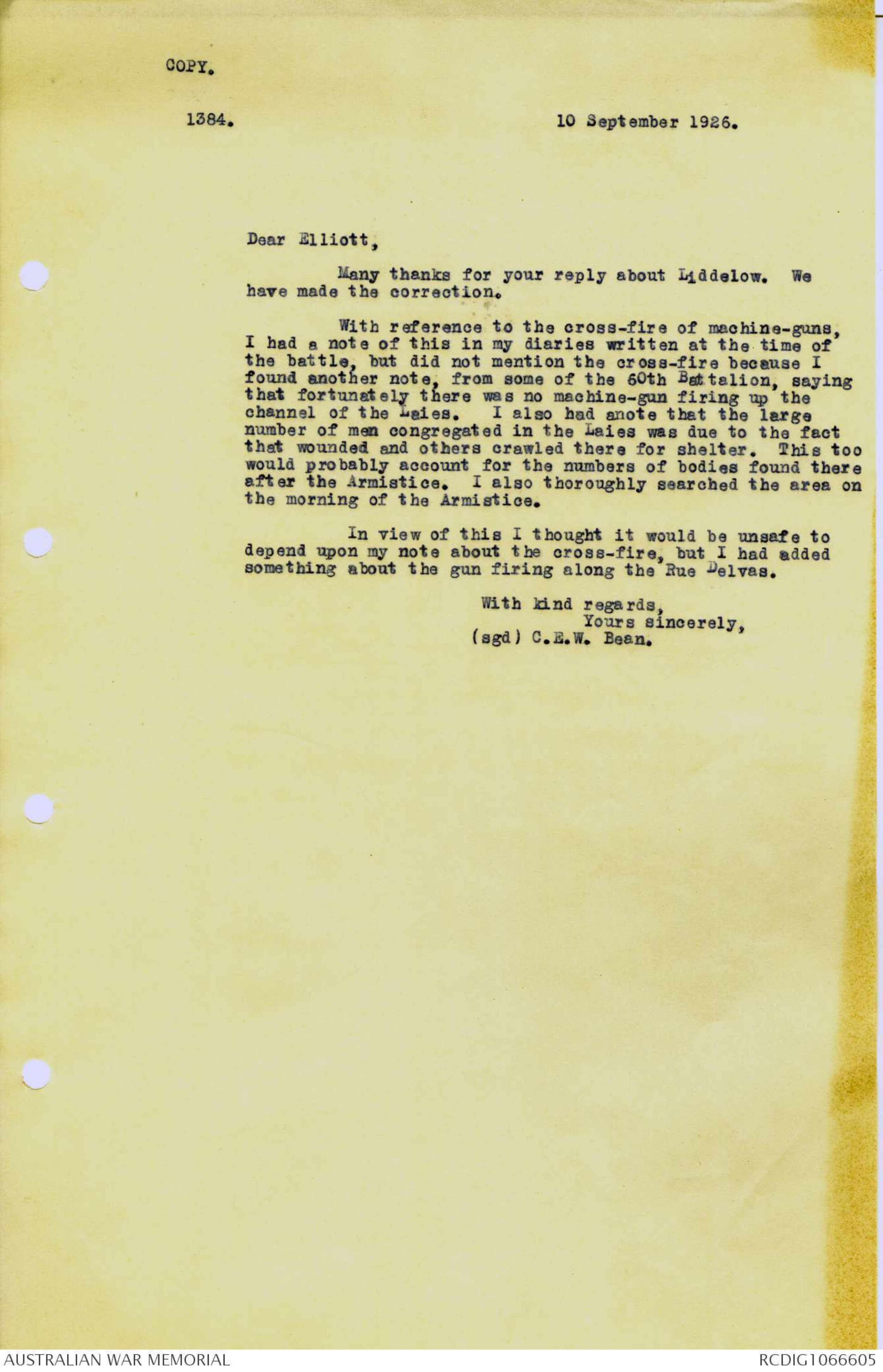
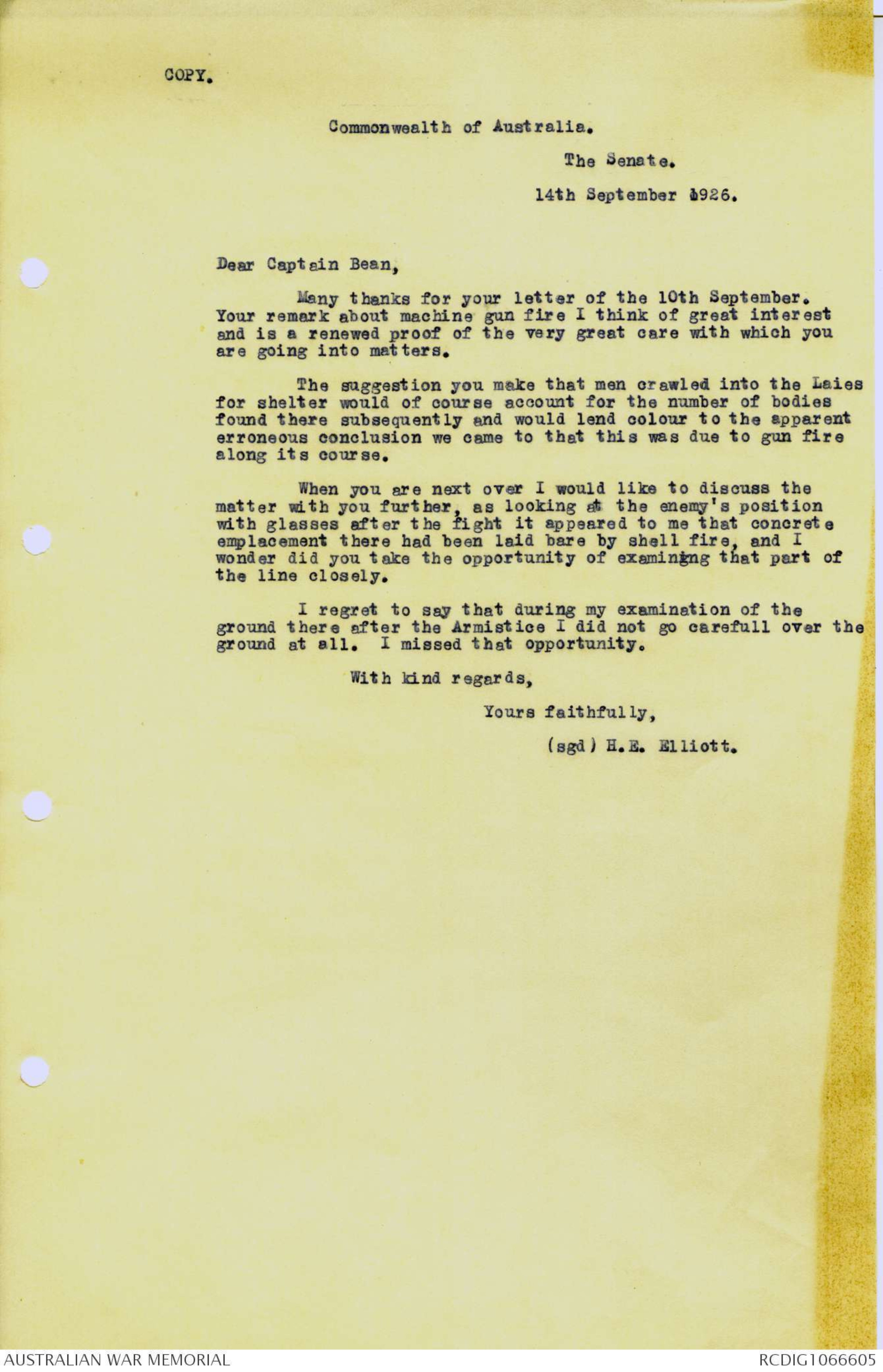
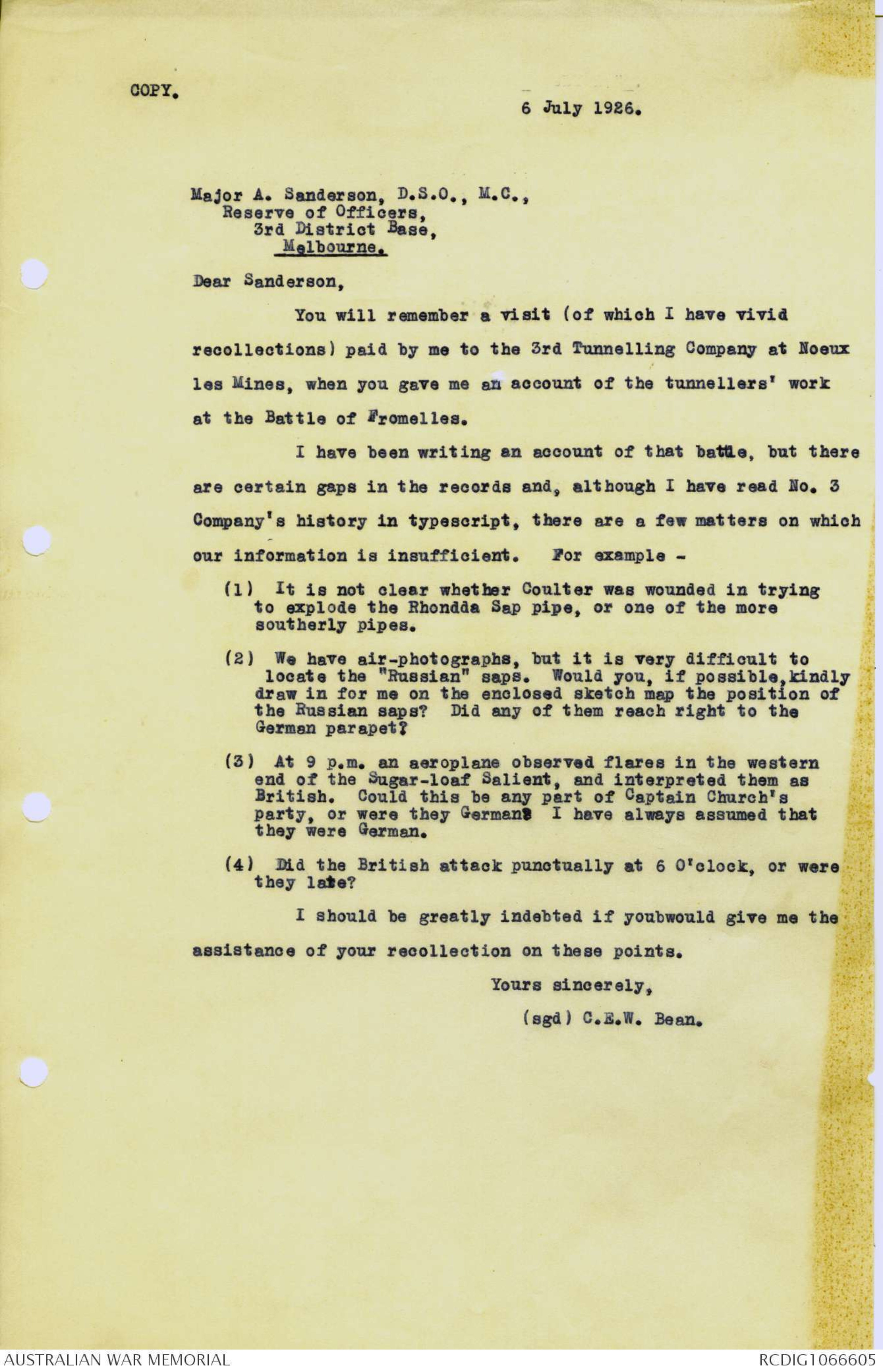
2.
The Germans had excellent bombers and a profusion of bombs, whilst
we did not have sufficient bombs or sandbags at the time. The
men were too crowded. I saw Lt. Cumming there in charge of part x
of the line. Both he and lt. Matthews were wounded and taken
prisoner later in the night.
I returned to where Lt.Col. Cass was, after thinning the
line somewhat and setting organised parties digging a sap back to
H.Q. Capt. Gibbins was now giving his report in to Lt. Cols. Cass
and McConaghy. He had taken charge of, and well organised, for
defence, the left half of our front, up to where the 8th Bde had
been withdrawn, and remained in charge of this sector until the
operation ceased on the following day.
I told Lt. Col. Cass what the situation was. He ordered me
to collect bombs and bombers for the repulse of the Germans. It
was impossible to get bombers as each Bn. only had a platoon of
bombers in tho se days and these were already in action. However
55th Bn. H.Q. was fixed in a neighbouring dugout, and I set about
getting more material forward from our original front line to the
new one.
Word came back for more bombs and bombers for Lt. Matthews,
and Lt. Col. McConaghy ordered me to go forward to the assistance
of this officer. My previous journey had been so difficult, slow,
and dangerous that I decided this time, for the sake of quickness,
to get forward from the right after traversing the German original
front line. I started out along this line with a couple of men,
and found 19 Germans hiding in a dugout. These I sent to the
A.P.M. under an escort after thoroughly frightening them with
some rifle and revolver shooting. I then proceeded on my way
preceded by two men, all the time passing men who were hurrying in
the opposite direction and who warned us not to go further. We
continued on our way, and when the two men who were with me turned
a certain traverse I heard a cry of "Haands Oop! Haands Oop!",
immediately followed by the explosion of a bomb, I should judge,
six feet away. I waited for some sign of what happened had
happened, did not observe any, so concluded that the Germans had
accounted for my two men and would continue along the trench.
I then went back to Lt.Col. McConaghy, between whom and myself
there was not a single fighting man, and told him that, unless he
left his dugout, he would be captured. He would not believe me,
and thought this was a ruse on my part to avoid going to the
assistance of Lt. Matthews. He apologised later. I then went to
Lt.Col. Cass and gave him the same information. He ordered me to
res ist it. I knew that the only feasible way to do this was with
bombers and that these could only now be obtained from our reserves.
I went to Capt. Fanning for them. He had charge of two
coys of 56th Bn. in our original front line. He would not at
first give the bombers to me, but, under pressure, at last gave me
a section. I returned with the section to find that Lt.Col.
McConaghy had been driven from his dugout to the head of the sap,
when our men went out on the parapet to oppose the Germans, but
had been sniped. Had the Germans pushed on another 50 yds the
whole of the troops occupying the old enemy position at that time
must have been captured. My team of bombers now set to work,
drove the Germans back and held them at bay for a long time (two
of them subsequently received the D.C.M. for this work) until they
became exhausted and were driven back to the head of our sap.
At about this time an officer mentioned the advisability of
surrendering with the men in the forward positions as the position
appeared so hopeless. However he carried on with his work and
subsequently received the M.C.
Capt. Gibbins was t hen ordered to charge the advancing
Germans with what members of his company he could get together.
3.
He attempted this, but the Germans being in the trench inflicted
casualties on the party and badly wounded Lieuts K.R. Wyllie and
Denoon. This attack, though very gallantly attempted, was
costly and entirely unsuccessful in attaining its object. This
will be the action which is commonly referred to as the rear-guard
action which was conducted by Capt. Gibbins and was made in daylight
on the morning of 20th July.
I now presented the situation to Lt.Col. Cass again, and he
ordered me to drive the Germans back with the rifle and then with
the bayonet. The use of the bombs and bombers was the only
method by which the Germans could have been moved from their
position or even held up at this time, as they always had their
bombing parties covered with rifle or M.G. fire from the rear.
Even at night they did this with the assistance of flares which
they fired over the portion of the trench they were attacking.
We had gradually been withdrawing our men in accordance with
orders received, but there were still many men to come. I decided
to try getting on the parapet again, but with bombs this time,
and accordingly led a party of men (who would not face the risk
alone) parallel to and a little distance away from the parapet
and out of sight of the Germans, and then closed in on the trench
and threw our bombs in. I was slightly wounded upon the chin in
doing this, evidently by a sniper. We then returned to the saphead
where we had started out from and awaited the return of the
Germans, hoping to repeat the trick upon them, but we had evidently
inflicted casualties and they must have been puzzled as they
ceased bombing and did not approach again before we left the
position. I kept about six men there with me whilst the remainder
of our men xxxxxxxx evacuated the position via the sap or
clambered out of the trench alongside Lt.Col. Cass's dugout. The
Germans followed them up with bombs. When there appeared to be
nobody else to come back and it was useless to remain I told our
men to get back to our trenches, and started out myself. I
thought that Lt.Col. Cass was still in his dugout, but it was now
too dangerous to go to it. However, Lt.Col. Cass was evidently
one of those who retired over No-Man's Land. I attempted to
return along the sap, but it was congested with wounded and
escaping men, and for some of the distance I went alongside the
sap in the open, jumping down into it from time to time to avoid
the murderous M.G. fire with which the Germans were now sweeping
No-Man's Land and the vicinity of the sap. In this way I regained
our xxx trenches at about 10 a.m. on the 20th July, to
learn that Lt. Col. Cass was there and that Capt. Gibbins had xxx
been killed whilst helping a wounded man to get into our trenches
from No-Man's Land.
I spent some time clearing our end of the sap in order
that slightly wounded men from dugouts might get in quickly from
No-Man's Land, and in getting wounded men from dugouts as there
was great congestion there, and the Germans were shelling the
spot regularly. This was near the head of Brompton Avenue.
Finally the 55th Bn. received the order to move back to
billets.
In passing an advanced dressing station in the Rue du Bois
I took my final part in this operation by being rude to the AMC
personnel there. This had the effect of getting stretchers up to
the line for the removal of the large number of wounded who were
lying there.
I joined Lt.Col. McConaghy and Capt. Woods at 14th Bde HQ
where we all had a chat with Col. Pope (who was then Brigadier)
at about one or two p.m. He was then perfectly normal though I
4.
was reported as being prepared to give evidence against him at an
enquiry which subsequently took place. This was in accordance
with a policy which does not concern this narrative.
Capt. Gibbins was, undoubtedly, the fighting leader who got
the best results for the Bn., in action, while Lieut. Matthews
and his men put up a magnificent fight on the right flank of the
position.
Capt. Palmer rendered splendid service in organising and
sending forward supplies in more than sufficient quantities when
we most needed them, i.e., after midnight and until the withdrawal.
Lt.Col. Cass as the representative of the division was in
charge of the troops in the conquered area, and, I believe,
maintained communication with the Division.
Lt.Col. McConaghy kept close touch with the 14th Bde. H.Q.
throughout.
Major Holland was in charge of the 55th Bn troops who were
in our original trench system.
I was in charge of the 55th Bn when it carried out its first
and only raid in the Fleurbaix area on about 303/9/16. This raid
was an x unqualified success, was made on one of the strongest
positions of the German trenches (that which included Foray House
as its H.Q.), and produced the one prisoner required for
identification purposes. The number of German killed was computed
at 17. Capt. S. A. Pinkstone was in charge of the raid with his
H.Q. in our front line. Capt. E. W. Stutchbury was O.C. assault
for which he was awarded the M.C., and Lieut. Gitsham accompanied
him. After the 55th Bn.
After the 55th Bn. went to the Somme, officers who performed
quite exceptional services were Capts. Chapman and Palmer. Ever
ready to fight and burning with patriotism they were two officers
who placed discipline, efficiency, integrity, and sacrifice upon a
very high pedestal, and taught their subordinates to worship those
qualities. This was especially the case with Capt. Chapman.
Capt. Palmer was killed early in 1917 in Sunray Trench, when
acting as O.C. front line. Capt. Chapman volunteered to take his
place, but must have lost his way, for he was not seen again after
leaving Bn H.Q. until his body was found in the German support line
minus a leg, and with several dead Germans lying around him.
A word about Capt. Gibbins. I examined his papers when he sat
for Non-Commissioned rank in the 3rd Bn. They were among the best
in the Bn. He was a man of fairly good education and had an infinite
capacity for taking pains with his work. He seemed to collect
the best men of the Bn. around him, and the members of his coy, to a
man, were intensely proud of and loyal to him. He it was who trained
Capts. Chapman and K. Wyllie and Lieut. Denoon, all of whom have
been awarded the M.C., and I think that Capt. Wyllie has for long
been admitted to be the most successful coy commander in the Bn.
His men worship him.
Ranks of officers have been given as I believe they were at the
time the incidents described, and with which they names are coupled,
occurred. Since the occurrence of the events written of above, I
think a more complete history of the 55th Bn has been kept than
anything I could write from memory.
COPY.
13 August 1926.
1312.
Lieutenant C. T. Agassiz,
39, Forbes Street,
Newtown.
Dear Agassiz,
I have mentioned the facts which you told me, and
enclose copies of the pages in question. Would you kindly note
in the margin if they are in any way incorrect, and let me have
them back?
On searching through the casualty lists and lists of
prisoners we find that Reay and Grimes appear together, but
cannot identify "Driscoll" of the 55th Battalion; and I think
that your memory must have slipped you up as regards the name
of this man. The Driscoll captured by the Germans was unquestionably
of the 8th Machine Gun Company (and originally a 31st
Battalion man). I would much like to get the name of this chap
whom you mentioned. If you happen to be near the Barracks any
day, either I or my staff can show you the whole list of killed,
wounded and missing of the 55th Bat talion, and you might be able
to spot the name from among them; or else it is possible that
you may have some other way of refreshing your memory. If so,
I should be most grateful if you could think over the names
again.
Yours sincerely,
(sgd) C. E. W. Bean.
Dear Capt. Bean,
After a search of my own records I find the man's
name was Gribben - 8th reinforcements to 3rd Battalion, and
his no. 2723? The rest is quite O.K. but I am sorry I
misled you. Forgiven? Yes. Cheerio.
Yours sincerely,
(sgd) Cecil T. Agassiz.
COPY.
1314. 13 August 1926.
Brigadier-General H.E. Elliott, C.B.,C.M.G.,D.S.O.,D.C.M.,V.D.,
The Senate,
Melbourne.
Dear Elliott,
I am taking the liberty of sending you part of the
typescript of the chapters dealing with the operations of your
brigade in the Battle of Fromelles, and should be very grateful if
you would look through it and let me know whether, so far as you are
aware, it is (1) generally, and (2) literally, accurate. I should
also be pleased to have any notes and comments which occur to you.
Yours sincerely,
(sgd) C. E. W. Bean.
COPY.
Royal Automobile Club Building,
94-98 Queen Street,
Melbourne. 17 August 1926.
Dear Captain Bean,
Many thanks for your letter of the 13th instant enclosing
part of the typed scrip of the chapters dealing with the
operations of the 15th Brigade in the Battle of Flanders.
I have read it through very carefully and must congratulate
you on the way you have pieced out the different narratives.
I have nothing to add to the report itself but the following
facts may be of interest to you.
You will possibly remember that on arrival in France
each officer was presented with an official booklet, issued by
the French staff, translated into English, which summarised the
conclusions which had been come to by the French staff in regard
to trench warfare, as understood up to that time.
One of the axioms which it laid down in regard to a
"trench to trench" attack wasthat such an attack could not possibly
succeed if the enemy's front line trench was distant more than
200 yards from the "hop off".
Bearing this in mind I myself had early come to the
conclusion that, so far as my brigade was concerned, if this
axiom was sound, success was impossible and I was naturally
greatly depressed by the prospect, although naturally in loyalty
to the higher command I had to carefully conceal my feelings and
even my thoughts on the subject.
However, shortly before the battle a major from General
Haig's staff (I cannot recall his name at this time but it might
appear in the nrigade diary) visited my section of the line, and
accompanied me on an inspection of the line and on a reconnaissance
of No-Man's Land through a sap in the right sector. On our
return near a spot called V.C. corner I stopped and holding up the
pamphlet in my hand, I said to him: "Major, you have read my plan
of attack and the orders thereon and have approved of them. I want
you now to tell me as man to man, in view of the fact that you
have had nearly two years experience in this fighting as against
my ten days, whether this attack can succeed, for according to
the axioms laid down in this pamphlet which your staff has issued
to us we cannot succeed." He hesitated and changed colour, and
said very earnestly, "Sir, since you have put it to me in that way
I must answer, but I expect the result to be ' a bloody Holocaust'."
In view of that expression of opinion, which undoubtedly
was very sound and founded on good reason, I have always been at a
loss to learn why the attack was persisted in.
Further it may interest you to learn that the little
church at Fromelles on the Aubers Ridge, overlooking our position,
and which was constantly under shell-fire by our guns, had actually
been transformed, by the enemy, into a solid block of concrete
and was used by him as an observation post from which he could
command a view right into our lines, and it is no doubt from this
point that he observed the reinfocement of our front lines on the
day of the battle to which you refer in your narrative.
After the armistice I was sent by General Hobbs to
select a position for the 5th Divisional Memorial, and recommended
that it should be established on the butt at PolygonWood. I took
the opportunity to visit my brother's grave at Dickebusch and then
returned via Lille and Fromelles.
2.
The church was still in its original condition a solid mass
of reinforced concrete, the whole interior having been so filled
in. There was a little winding staircase from the rear of the
church leading up into a lookout position. Near the ridge of
the church there was a small space for inserting a telescope.
From this spot a wonderfully accurate view of our position was
revealed and it occurred to me afterwards how foolish we had
been not to take advantage of the spire of the church in Fleurbaix
from which a similar view no doubt could have been obtained
of the enemy's position.
A point which you do not mention in your narrative about
the enemy's position is that the enemy had concrete machine-gun
emplacements placed so that the banks of the Laies were under
fire, and similar emplacements where the main road crossed his
lines. The road and the river joined right on our parapet.
The enemy thus had the apex of a triangular field of fire, which
he was always anxious to get in his defensive positions, pointed
towards us and from the appearance of the bodies which lay along
the bank of the Laies and along the edge of the road it is
evident that the different waves in these localities walked into
a stream of lead which was directed along the course of the river
and road respectively, and there is no doubt in my mind that in
a defensive position the effect of machine-guns employed in thus
creating a barrage is enormously greater than when used in the
ordinary fashion as a man when using a hose would sprinkle a
garden. In such tactics the enemy was considerably ahead of us
at this stage of xxxx the war.
I shall look forward with great interest to the conclusion
of the narrative in regard to the other brigades.
Yours sincerely,
(sgd) H. E. Elliott.
P.S. I notice one omission from your list of 59th officers, namely
the name of Lieutenant R. Liddelow, afterwards Captain R.
Liddelow. He was an officer of the New Zealanders and his elder
brother, Captain Aubrey Liddelow, who was killed on that day, had
applied for his transfer to the 59th and this had been granted in
Egypt. R. Liddelow was severely wounded and invalided home.
He is now Secretary of the Victorian Electricity Commission under
Sir John Monash. Wrigley, adjutant of the 60th, is now one of
the party at Englefield via Balmoral, Victoria. Major Hewett of
the 59th is employed by Messrs. Lever Bros, Sunlight soap, Sydney.
Previous to his joining the 7th Battalion he was an overseer of a
plantation in the New Hebrides. Captain Akeroyd, who was again
severely wounded at the battle of the 5 July 1918 which we
carried on to the left of the battle of Hamel, is now inspector
of prisons in Victoria.
COPY.
1330. 25 August 1926.
Dear Elliott,
Many thanks for your letter and assistance, which I
value. I take it that Lieutenant R. Liddelow was not wounded
in this actual battle, but later in the war? If, however, I
am wrong in this, would you kindly let me know?
Yours sincerely,
(sgd) C. E. W. Bean.
27.8.26.
Dear Capt. Bean,
With reference to above, I have just rung up
Liddelow and verified my recollection of this, and he states
that I am correct - he was severely wounded in the actual
battle.
Yours faithfully,
(sgd) H. E. Elliott.
COPY.
1384. 10 September 1926.
Dear Elliott,
Many thanks for your reply about Liddelow. We
have made the correction.
With reference to the cross-fire of machine-guns,
I had a note of this in my diaries written at the time of
the battle, but did not mention the cross-fire because I
found another note, from some of the 60th Battalion, saying
that fortunately there was no machine-gun firing up the
channel of the Laies. I also had anote that the large
number of men congregated in the Laies was due to the fact
that wounded and others crawled there for shelter. This too
would probably account for the numbers of bodies found there
after the Armistice. I also thoroughly searched the area on
the morning of the Armistice.
In view of this I thought it would be unsafe to
depend upon my note about the cross-fire, but I had added
something about the gun firing along the Rue Delvas.
With kind regards,
Yours sincerely,
(sgd) C. E. W. Bean.
COPY.
Commonwealth of Australia.
The Senate.
14th September 1926.
Dear Captain Bean,
Many thanks for your letter of the 10th September.
Your remark about machine gun fire I think of great interest
and is a renewed proof of the very great care with which you
are going into matters.
The suggestion you make that men crawled into the Laies
for shelter would of course account for the number of bodies
found there subsequently and would lend colour to the apparent
erroneous conclusion we came to that this was due to gun fire
along its course.
When you are next over I would like to discuss the
matter with you further, as looking at the enemy's position
with glasses after the fight it appeared to me that concrete
emplacement there had been laid bare by shell fire, and I
wonder did you take the opportunity of examining that part of
the line closely.
I regret to say that during my examination of the
ground there after the Armistice I did not go carefull over the
ground at all. I missed that opportunity.
With kind regards,
Yours faithfully,
(sgd) H. E. Elliott.
COPY.
6 July 1926.
Major A. Sanderson, D.S.O., M.C.,
Reserve of Officers,
3rd District Base,
Melbourne.
Dear Sanderson,
You will remember a visit (of which I have vivid
recollections) paid by me to the 3rd Tunnelling Company at Noeux
les Mines, when you gave me an account of the tunnellers' work
at the Battle of Fromelles.
I have been writing an account of that battle, but there
are certain gaps in the records and, although I have read No. 3
Company's history in typescript, there are a few matters on which
our information is insufficient. For example-
(1) It is not clear whether Coulter was wounded in trying
to explode the Rhondda Sap pipe, or one of the more
southerly pipes.
(2) We have air-photographs, but it is very difficult to
locate the "Russian" saps. Would you, if possible, kindly
draw in for me on the enclosed sketch map the position of
the Russian saps? Did any of them reach right to the
German parapet?
(3) At 9 p.m. an aeroplane observed flares in the western
end of the Sugar-loaf Salient, and interpreted them as
British. Could this be any part of Captain Church's
party, or were they German? I have always assumed that
they were German.
(4) Did the British attack punctually at 6 O'clock, or were
they late?
I should be greatly indebted if youbwould give me the
assistance of your recollection on these points.
Yours sincerely,
(sgd) C. E. W. Bean.
 Deb Parkinson
Deb ParkinsonThis transcription item is now locked to you for editing. To release the lock either Save your changes or Cancel.
This lock will be automatically released after 60 minutes of inactivity.